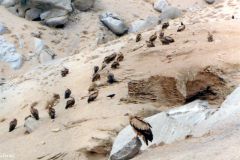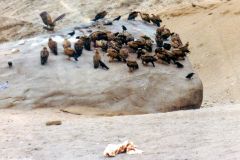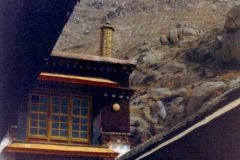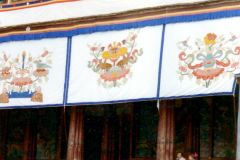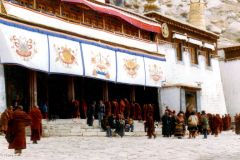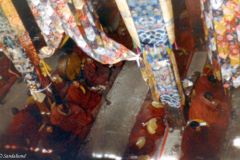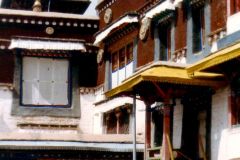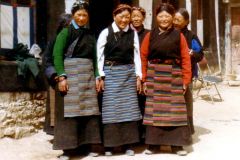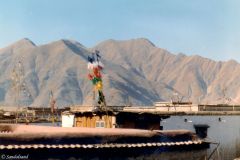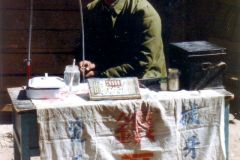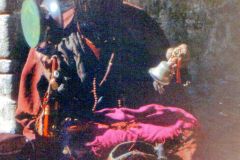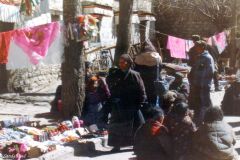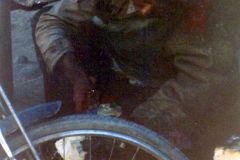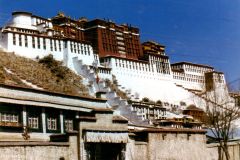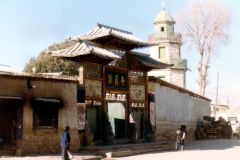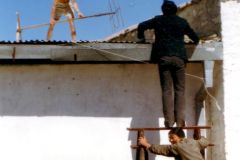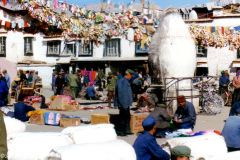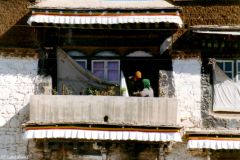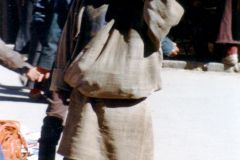The story from my days in Tibet continues here with the bulk of the stay. I spent 11 days in all, back in 1985.
This article is part of a diary based travelogue from a six month journey in 1985 to several countries in East and South East Asia: Japan, Taiwan, China, Philippines, Singapore, Malaysia and Thailand.
Monday 25.2.1985, Lhasa
We tried to get into the Potala Palace (Dalai Lama’s palace) but it was closed to both pilgrims and others. Instead we walked the streets. We found a small restaurant – Muslim this time too – near the CAAC. (Right across the street, near the Chinese fresh food market.) It served good tea and good bread. I’m absolutely positive that it would never get an approval from the Health authorities at home. On the other hand that is the very reason why we find it (and many other cafes as well) so interesting.
We looked around for a while and found the Tibetan market too. There we bought some loaves of bread and yak butter, they both tasted very well. Later we bought natural yogurt, also very tasty.
Apart from that the yak tea is not particularly good, being too sweet. But that is what the hosts at our hostel are serving and we can’t really reject their serving.
Tuesday 26.2.1985, Lhasa
A burial
We rose very early and walked north until we stood at the foot of the hills. There we watched a Tibetan “celestial burial” or “sky burial” as it is also called. The term “burial” is not really proper for what we experienced. The dead person was cut to pieces and the bones crushed with a mallet. All the remains were laid out on the rocks for the ravens, hawks and vultures to devour. The vultures came sweeping down from the mountains with a wing span of at least 1.5 metres. What was left of the body was thereafter burned.
It was an immensely fascinating ritual.
Sera monastery
Later we walked over to Sera, one of the nine or ten remaining monasteries in Tibet – as compared to the 2500 before 1959. Sera was very fascinating but has apparently been little cared for lately.
We were lucky and ran into a mass for the monks. In a number of around 200 they sat in the temple singing sutras, or whatever it’s called. In between these chants the abbot mumbled a few words with a very deep voice, and then they all joined in again. Among these voices one could hear some who had not got to the age of voice change. There were actually quite a few young monks. We took this as a sign of a situation where the religion is not dying on this level.
The ordinary people are definitely hyper-religious. We constantly meet them in town mumbling prayers, twisting their prayer wheels, counting beads on necklaces and / or “work their way” around town by lying down flat on the street, rise up and lie down again.
We ate dinner in a café which had rice. This is a scarce staple in Tibet as is has to be imported from China and consequently becomes expensive. It was good to taste something else than noodles. Expensive is perhaps not the right word, less than a dollar may not really be characterised as expensive. Potatoes by the way are sold on the market but are apparently not prepared for dinner.
We rounded the day off with beers and a philosophical discussion.
Wednesday 27.2.1985, Lhasa
Today we visited the Potala, climbing the steps up and up, deep into the palace. We saw wonderful art treasures, the quarters of former Dalai Lamas and so on. Every new Dalai Lama built his new section. And everything is sacred of course. The Dalai Lamas are considered as some kind of god’s representative on Earth. Everywhere there was a sweet-like smell around us; it stemmed from all the burning wax-lights being upheld by new wax brought in by the constant stream of pilgrims and worshippers. It was a bad smell, made of yak fat.
There were lots of Tibetans inside and many and long queues. This is possibly because there is a festival around the New Year.
Thursday 28.2.1985, Lhasa
I slept a little longer than usual – lovely. Later I walked around in the market and the surrounding streets. Colleen did some shopping; she had to return to her university.
Several people have been looking for a money exchanger. Rumours are running on where to find one. Colleen and I found a Nepalese and exchanged at a rate of 150.
We ate lunch and dinner in a café right across the street from our hotel. The food was below average, too much oil and too hot. But it was cheap of course, a dollar and half.
Many restaurants have by the way been closed these days around New Year.
Friday 1.3.1985, Lhasa
I rented a bicycle at the hostel for 5Y and went out to the Drepung Monastery 7-8 km straight west. There was much interesting to see.
On the road down from the monastery I was “chased” by a Tibetan who wanted me to take a picture of him and for him. I tried the best I could to explain him that it was not possible with my camera. In the end he left.
I had thought of returning by way of the Summer Palace, but it didn’t open until a couple of hours later so I went home and posted some letters and postcards on the way.
We went later in the evening a group of eleven and ate at the good, little, simple restaurant. The cook had a shock, but we had fun. We rounded the evening off with beers, candle lights and a good time outside our rooms on the large terrace.
Saturday 2.3.1985, Lhasa
I walked around the market and into the Jokhang temple. The rest of the day I sat out in the sun, trying to get a tan.
I had dinner with a group of Danes and an Australian at the Snow Land hotel. It took its time to get the food and it wasn’t as we had ordered it.
Sunday 3.3.1985, Lhasa
I first checked if the nearest PSB (Public Security Bureau) was open. It wasn’t. The day was then spent in relaxing positions.
Monday 4.3.1985, Lhasa
It was neither yesterday nor today possible to get tickets with a bus to Xigaze, the second largest city in Tibet. I also found it difficult to find a lorry to hitch-hike with. I did however manage to get a month extension on my visa to China, at the PSB.
In the afternoon I heard that two of my Danish neighbours (Nille and Karen) had got hold of bus tickets to Golmud the next day. I bought the same ticket.
When I was in Tibet, Lhasa was the only “open” place. One had to fly in and out of Chengdu. Quite recently it had been possible to get a visa to Nepal in that country’s Lhasa consulate. With that purpose the PSB was able to issue a travel permit to go to Xigaze, stay one night and continue straight to the border. The entire journey Lhasa – Kathmandu was estimated to take three days, and not even strenuous.
Wise souls among us travellers reckoned fairly simply that by getting this travel permit one could quite legally visit Xigaze and the surrounding area, without necessarily cross the border to Nepal. It was still illegal to go the other way, from Nepal. Some used this opportunity, but it was not easy to get a transport.
Illegal travelling was of course no rarity, nor a new thing. The author of my guidebook writes that he spent seven weeks in Tibet in 1982, before the province was at all opened to individual tourism. A Danish girl I heard about had crossed in and out of Tibet for a couple of months, sometimes illegally, at other times legally.
One of the routes out of Tibet which was illegal was the road northwards to Golmud. That was the way I was going tomorrow with my acquired bus ticket. The police control is evidently not so very strong.
Read more
The introduction to this journey to East and South East Asia.
Previous chapter: 11 days on top of the world, in Tibet, few months after its opening up for individual travellers
Next chapter: The way out Tibet, into the forbidden city of Golmud
On YouTube I found a playlist of 33 videos from Tibet taken by a traveller that same year I was there, 1985. The photographer went to places I didn’t and I haven’t seen all 33 videos.

